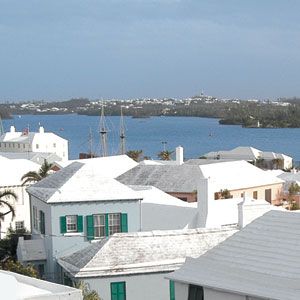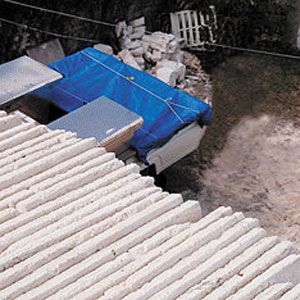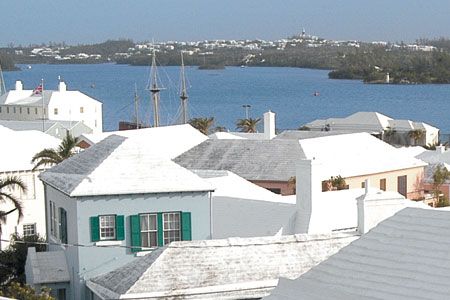
The thing about living in paradise is there’s always a catch. In the case of Bermuda, where This Old House has been filming the renovation of a 200-year-old Georgian house, hurricanes hit the small mid-Atlantic island summer and fall, toppling trees, rattling shuttered windows, and peeling off roofs. Oh, and then
there’s the absence of any fresh water source on the island.
As a result, Bermuda’s roofs have evolved over four centuries to do two things: protect houses against gale-force winds and funnel whatever the heavens rain down into large cisterns that feed household taps. By law, every house must collect 80 percent of the water that falls on its roof.
To build a traditional Bermudian roof, masons mortar rectangular slabs, or “slates,” of local limestone to each other over a hip-roof frame. Then they apply more mortar over the top and edges of the slates, filling the joints and giving the roof its traditional stepped shape. Along the lower edges of the roof, they sculpt a long concrete trough for a gutter, which directs rainwater to a pipe that filters it and funnels it into a cistern buried alongside the house. Then they give the whole roof structure a thin wash of cement. Finally, to keep rainwater as clean as possible on its way to the cistern, they paint the roofs with special nontoxic paint (a modern replacement for traditional lime wash), which must be reapplied every two to three years.
The result is a strong, nearly self-supporting structure that holds its own against the weather while sending clean water into the tank. It’s the best and cheapest way to supply fresh water — up to 30 gallons per person are needed per day — to the 60,000-plus residents of this tiny island nation. It’s also what accounts for Bermuda’s signature white rooftops, perfectly placed amid the palms and set off by the pastel houses for which the island is famous.
See images 2-6 for Steps

Water Sources
Rain is the time-honored water supply for native Bermudians (who have a natural resistance to the bits of debris and bacteria that make their way into their cisterns). But rooftop water collection can’t meet the needs of the island once tourist season kicks in. At the height of the summer, the island gets as many as 200,000 visitors. So hotels, hospitals, and other commercial operations must find other sources. In the late 1970s, the government started pumping water from “lenses,” underground aquifers where rainwater, which has made its way through the ground over the course of two years, rests atop heavier seawater. These lenses are still in use; a plant at a former military fort filters the water with reverse-osmosis technology, then chlorinates it for its journey along 30 miles of pipes to Bermuda’s towns.
Still, demand for water is outstripping supply by about 20 percent during peak seasons, so the government has resorted to water rationing. But by the summer of 2005, it hopes to begin desalinization, making seawater potable by removing the salt. The process uses more energy, so it’s considerably more expensive. But that’s the price of keeping paradise up and running.
See image 7.

